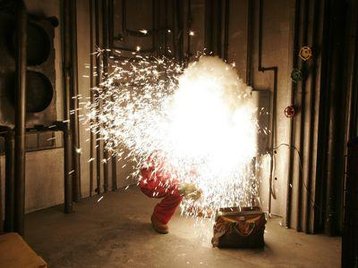Arc flash is a real risk in data centers. Arc flash incidents have killed and injured personnel, delayed commissioning and disrupted operations at numerous facilities around the world. In just one example, a series of arc flash incidents during construction of the US National Security Agency’s facility in Bluffdale, Utah, delayed the start of operations by more than a year.
What is an arc flash?
An arc flash is a rapid release of electrical energy through the air between two conductors. It can occur when an uncharacteristic flow of electricity – called an arcing fault – forces an exceptionally high current through copper or another conductive material. The resulting short circuit creates an explosion and releases a plasma fireball that can reach temperatures of more than 19,000°C – several times hotter than the surface of the sun.
Why arc flashes matter
Arc flash incidents can be life changing or fatal for personnel, even if the victim is some metres from the arc. Typical injuries include blindness, nerve damage, hearing loss, and harm to the lungs from inhaling hot and toxic gasses. The arc flash event may also send out shrapnel and molten metal, both of which can be propelled long distances.
The causes of arc flash
An arc can be initiated by a failure within electrical switchgear such as a breakdown of insulation or by the introduction of a conducting object that accidentally introduces a short circuit. In data center environments, some of the most common causes of arc flash include:
- Poor electrical contact
- Insulation failure
- Inadvertent contact with energised equipment
- Ageing electrical systems
- Inadequate maintenance of electrical systems.
Arc flash in data centers
Electrical equipment used in data centers that are susceptible to arc flash hazards include:
- Switchboards
- UPS systems
- Power distribution units
- Panel boards
- Busways
- Remote power panels
Arc flash risks may be increased by many of today’s trends in data center design and operation:
- Larger facilities with higher overall energy demand
- Greater server density increasing energy requirements per rack
- The use of fewer, larger transformers in the quest to improve overall energy efficiency
- Stringent availability requirements leading to a more frequent need to work on, or in close proximity to, energised equipment.
Arc flash risk management
Data center operators must undertake adequate consideration of arc flash risks as part of their responsibilities under health and safety legislation. Relevant regulations include:
- The NFPA70E ‘Standard for Electrical safety in the Workplace’
- The UK Management of Health & Safety at Work Regulations (1999)
- The Electricity at Work Regulations (1989).
An appropriate approach to the management of arc flash risk has three related elements:
1. Analyse the hazard
Calculating the potential severity of an arc flash event requires knowledge of system fault currents and protection clearance times. Typically, specialist software is used to analyse fault levels and detailed arc incident level calculations in accordance with IEEE 1584 are performed. Arc flash analysis and risk assessment are time consuming and require specialist knowledge to implement effectively. For this reason, many organisations choose to make use of external specialists for this work.
2. Design and implement appropriate mitigation measures
Since arc flash current is always less than short circuit current, an efficient protection assessment should be performed to select the proper settings for overcurrent protection devices, such as fuses and circuit breakers. The challenge here is to reduce potential arc flash energy without sacrificing selectivity, so the portion of a power system that is disconnected in response to an event is minimised.
A series of arc flash incidents during construction of the US National Security Agency’s facility in Utah delayed the opening by more than a year.
A number of newer technologies offer alternative forms of protection. Arc fault detection relays, for example, are triggered by light from the flash, current and sometimes sound. Other approaches to mitigation involve the automated introduction of an alternate current path in order to transfer the arcing fault and capture it, the use of remote switching equipment to remove personnel from high-risk areas and the use of arc resistant designed switch gear to contain and then channel arc flash incident energy away from the operator.
3. Manage residual risk
Once appropriate mitigation strategies are in place, an equipment operator must understand the residual risk, and take appropriate steps to manage them. These steps include: clear labelling of equipment showing the hazard risk categories and its boundaries; appropriate training for personnel involved with the operation and maintenance of switchgear; compliance with appropriate operation and maintenance procedures; and use of personal protective equipment (PPE) appropriate to the level of residual risk.
The last three steps are of particular importance in data center operations, where personnel with a high level of expertise in other areas of have little experience of electrical power systems, and where there can be a cultural reluctance to wearing appropriate PPE.
Jeremy Gadd is Managing Director at GSE Systems Ltd


